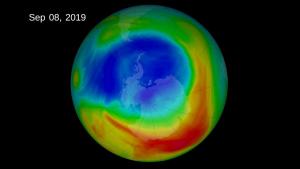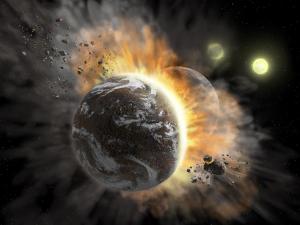Science
NASA and Google Achieve Quantum Supremacy

Electra, NASA’s powerful modular supercomputer, was also used in this collaboration with Google. It is a petascale supercomputer that saves significant amounts of water and power annually.
- Read more
- 298 reads
2019 Ozone Hole is the Smallest on Record Since Its Discovery

The 2019 ozone hole reached its peak extent of 6.3 million square miles (16. 4 million square kilometers) on Sept. 8. Abnormal weather patterns in the upper atmosphere over Antarctica dramatically limited ozone depletion this year.
- Read more
- 306 reads
When Exoplanets Collide

Artist’s concept illustrating a catastrophic collision between two rocky exoplanets in the planetary system BD +20 307, turning both into dusty debris. Ten years ago, scientists speculated that the warm dust in this system was a result of a planet-to-planet collision. Now, SOFIA found even more warm dust, further supporting that two rocky exoplanets collided. This helps build a more complete picture of our own solar system’s history. Such a collision could be similar to the type of catastrophic event that ultimately created our Moon.
- Read more
- 274 reads
In-Space News Conference to Review First All-Woman Spacewalk

NASA astronauts Christina Koch and Jessica Meir conduct the first all-women spacewalk.
- Read more
- 286 reads
B47 BREAKS OFF GETZ ICE SHELF__Ice shelf Getz smaller

B47 BREAKS OFF GETZ ICE SHELF
- Read more
- 329 reads
Joint Polar Satellite System’s Microwave Instrument Fully Assembled

The Joint Polar Satellite System-2’s fully assembled Advanced Technology Microwave Sounder instrument undergoes electromagnetic interference testing at the Northrop Grumman Aerospace Systems facility in Gilbert, Arizona.
- Read more
- 304 reads
NASA Sounding Rocket Technology Could Enable Simultaneous, Multi-Point Measurements — First-Ever Capability

A team of Wallops Flight Facility engineers will release these instrumented sub-payloads to demonstrate the distributed payload communications technology. The devices should collect and transmit about four minutes of data before reentering the atmosphere.
- Read more
- 305 reads
Assembler robots make large structures from little pieces

Photo shows two prototype assembler robots at work putting together a series of small units, known as voxels, into a larger structure.
- Read more
- 284 reads
Human Rights
Fostering a More Humane World: The 28th Eurasian Economic Summi

Conscience, Hope, and Action: Keys to Global Peace and Sustainability

Ringing FOWPAL’s Peace Bell for the World:Nobel Peace Prize Laureates’ Visions and Actions

Protecting the World’s Cultural Diversity for a Sustainable Future

Puppet Show I International Friendship Day 2020



